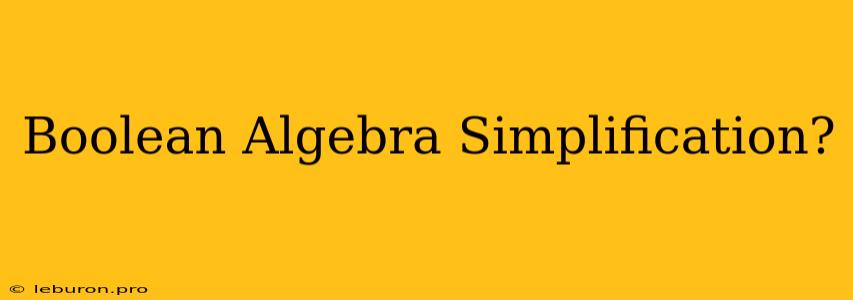Boolean algebra simplification is a fundamental concept in digital logic design and computer science. It involves manipulating Boolean expressions, which are expressions that use logical operators like AND, OR, and NOT, to achieve simpler and more efficient representations. This simplification is essential for creating optimized digital circuits, reducing the number of logic gates required, and improving circuit performance. In this article, we will delve into the intricacies of Boolean algebra simplification, exploring its various techniques and applications.
Understanding Boolean Algebra
Boolean algebra is a branch of algebra that deals with logical operations and their relationships. It utilizes variables that can assume only two values: true (1) or false (0). The basic operations in Boolean algebra are:
- AND (· or ∧): The AND operation yields true only if all its operands are true. For example, A · B is true only if both A and B are true.
- OR (+ or ∨): The OR operation yields true if at least one of its operands is true. For example, A + B is true if either A or B or both are true.
- NOT (¬ or ~): The NOT operation inverts the truth value of its operand. For example, ¬A is true if A is false, and vice versa.
These operations are used to construct Boolean expressions, which represent logical relationships between variables. For instance, the expression (A · B) + (¬A · C) represents a logical circuit that outputs true if either (A and B are true) or (A is false and C is true).
Importance of Simplification
Simplifying Boolean expressions is crucial for several reasons:
- Reduced Circuit Complexity: By reducing the number of logical operations, simplification minimizes the number of logic gates required to implement the circuit. This translates to lower cost, smaller size, and improved efficiency.
- Enhanced Performance: Simpler circuits have fewer delays and propagation times, leading to faster and more reliable operation.
- Improved Readability: Simplified expressions are easier to understand and analyze, facilitating debugging and maintenance.
Techniques for Boolean Algebra Simplification
Various techniques can be employed to simplify Boolean expressions. Some of the most commonly used methods include:
1. Boolean Identities
Boolean algebra is based on a set of fundamental identities that can be used for simplification. These identities, derived from truth tables, define the properties of logical operations. Some key identities include:
- Commutative Law: A + B = B + A, A · B = B · A
- Associative Law: (A + B) + C = A + (B + C), (A · B) · C = A · (B · C)
- Distributive Law: A · (B + C) = (A · B) + (A · C), A + (B · C) = (A + B) · (A + C)
- Identity Law: A + 0 = A, A · 1 = A
- Complement Law: A + ¬A = 1, A · ¬A = 0
- De Morgan's Law: ¬(A + B) = ¬A · ¬B, ¬(A · B) = ¬A + ¬B
2. Karnaugh Maps
Karnaugh maps (K-maps) provide a visual method for simplifying Boolean expressions with two or more variables. They represent the truth table of a function in a graphical format, where adjacent cells represent adjacent minterms (product terms). By grouping adjacent cells with '1' values, simplified expressions can be derived.
3. Algebraic Manipulation
Simplification can also be achieved through algebraic manipulation, applying Boolean identities and laws. This method involves strategically substituting equivalent expressions and simplifying terms.
4. Quine-McCluskey Method
The Quine-McCluskey method is a tabular method for simplifying Boolean expressions involving multiple variables. It systematically combines minterms (product terms) with adjacent terms, resulting in a simplified expression.
Applications of Boolean Algebra Simplification
Boolean algebra simplification finds numerous applications in various fields, including:
- Digital Circuit Design: The simplification of Boolean expressions is fundamental in designing digital circuits. It leads to more efficient and cost-effective implementations of logic gates and other digital components.
- Computer Architecture: Boolean algebra is crucial for understanding the workings of computer systems, including logic circuits, memory units, and arithmetic logic units (ALUs).
- Software Engineering: Simplification techniques can be applied to optimize code, reduce computational complexity, and improve program performance.
- Artificial Intelligence: Boolean algebra is used in machine learning and artificial intelligence applications, particularly in areas like decision-making and logic programming.
Conclusion
Boolean algebra simplification is an essential tool in digital logic design and computer science. By simplifying Boolean expressions, we can reduce circuit complexity, enhance performance, and improve readability. Different techniques, including Boolean identities, Karnaugh maps, algebraic manipulation, and the Quine-McCluskey method, are used to achieve simplification. The applications of Boolean algebra simplification extend across various domains, including digital circuit design, computer architecture, software engineering, and artificial intelligence, highlighting its significance in modern technology. Further exploration of Boolean algebra and its simplification techniques will continue to contribute to the advancement of these fields.
